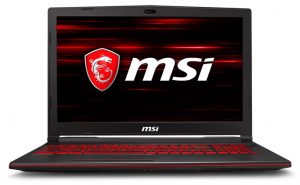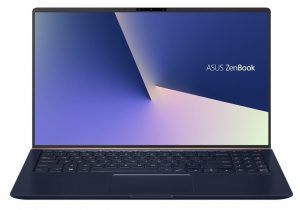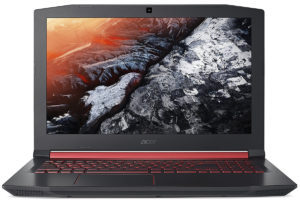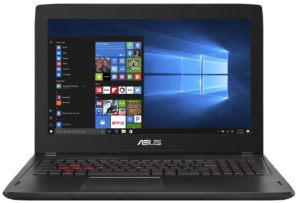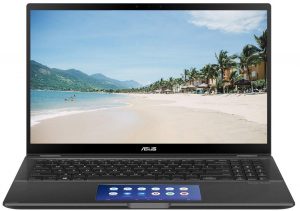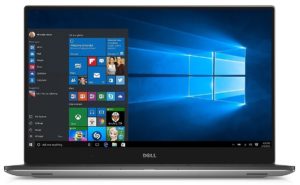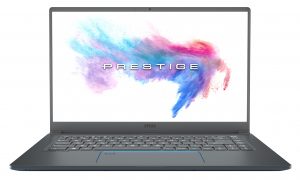NVIDIA GeForce GTX 1050 vs GTX 1050 Max-Q – power or efficiency
 Max-Q technology allows powerful GPUs to fit in slim laptops. In short, you can have a light, slim, and portable device with a fast GPU inside – and you don’t need biceps like Arnold when you have to carry your notebook. The Max-Q GPUs have another good side – they have smaller power limits and reduced frequencies than the full-blown variants and that’s why they don’t dissipate much heat and don’t require significant cooling like the standard non-Max-Q VGAs.
Max-Q technology allows powerful GPUs to fit in slim laptops. In short, you can have a light, slim, and portable device with a fast GPU inside – and you don’t need biceps like Arnold when you have to carry your notebook. The Max-Q GPUs have another good side – they have smaller power limits and reduced frequencies than the full-blown variants and that’s why they don’t dissipate much heat and don’t require significant cooling like the standard non-Max-Q VGAs.
Like always, there are some drawbacks – the Max-Q GPUs are much or less slower than the standard GPU variants. That’s the price you have to “pay” for a thin and light machine with a fast GPU. But the Max-Q tech isn’t “taking away the sunshine” from every video card, don’t get us wrong – those graphics adapters are still powerful-enough (they don’t have additional hardware cut-downs) but because of the low power limits and frequencies, there is a performance hit – which is normal.
Today it’s time to compare the low-end GTX card and its Max-Q variant – GTX 1050 and GTX 1050 Max-Q. We have to discover how much speed the Max-Q tech takes away from the GTX 1050.
You can have a look at our previous comparison between full-blown and Max-Q GPUs – GTX 1650 Max-Q vs GTX 1050 Ti and RTX 2070 Max-Q vs RTX 2060
See all configurations with GeForce GTX 1050 / GeForce GTX 1050 Max-Q
Contents
Specs overview
The GeForce GTX 1050 and GTX 1050 Max-Q are Pascal GPUs. They are based on the same GP107 chip. The GTX 1050 has 640 shader units, 16 ROPs, 7000MHz memory clock, 1354MHz/1493MHz base/boost frequencies, and 128-bit memory bus.
The GTX 1050 Max-Q is essentially the same graphics adapter but it has reduced TGP and its frequencies are lower too – 1139MHz/1328MHz. The memory clock is the same – 7000Mhz and the core frequencies aren’t that far away from the standard version ones. So maybe there is a possibility that the Max-Q GPU to be not that far away in terms of FPS results when compared to its “normal” sibling. Our test will show the answer.
GPU comparison table
| GeForce GTX 1050 | GeForce GTX 1050 Max-Q | |
|---|---|---|
| Architecture | Pascal | Pascal |
| GPU chip | GP107 | GP107 |
| Shader units | 640 | 640 |
| ROPs | 16 | 16 |
| Base Clock (MHz) | 1354 (+19%) | 1139 |
| Boost clock (MHz) | 1493 (+12%) | 1328 |
| Memory clock (MHz) | 7000 | 7000 |
| Memory size (MB) | 2048-4096 | 2048-4096 |
| Memory type | GDDR5 | GDDR5 |
| Memory bus width (bit) | 128 | 128 |
| TGP (Total Graphics Power) | 75W (+74%) | 43W |
| DirectX version | 12.1 | 12.1 |
| Technology | 14nm | 14nm |
| RTX capabilities | No | No |
| Release date | 01.2017 | 01.2018 |
| Detailed specs | Link | Link |
That enough, it’s time for benchmarks and some games.
Synthetic benchmarks
Just 6% between the normal one and the Max-Q variant. As we’ve informed you above, the full-blown card has higher clocks and TGP – that’s all. Maybe that’s why the Max-Q is so close in those synthetic benchmarks.
Results are from the 3DMark: Fire Strike (Graphics) benchmark (higher the score, the better)
Results are from the Unigine Superposition benchmark (higher the score, the better)
| GTX 1050 over GTX 1050 Max-Q | 3Dmark Fire Strike (G) | Unigine Heaven 3.0 | Unigine Heaven 4.0 | Unigine Superposition | Average difference % |
|---|---|---|---|---|---|
| NVIDIA GeForce GTX 1050 | +10% | +3% | +5% | +7% | +6% |
| NVIDIA GeForce GTX 1050 Max-Q |
Gaming tests
Let’s put aside the synthetics and we’ll reveal the real-life gaming test – this is what matters the most.

| CS:GO | HD 1080p, Low (Check settings) | HD 1080p, Medium (Check settings) | HD 1080p, MAX (Check settings) |
|---|---|---|---|
| NVIDIA GeForce GTX 1050 | 163 fps | 160 fps (+10%) | 122 fps (+15%) |
| NVIDIA GeForce GTX 1050 Max-Q | 176 fps (+8%) | 145 fps | 106 fps |
Normal, 10% to 15% difference in CS:GO, we were expecting the same gap.

| DOTA 2 | HD 1080p, Low (Check settings) | HD 1080p, Normal (Check settings) | HD 1080p, High (Check settings) |
|---|---|---|---|
| NVIDIA GeForce GTX 1050 | 112 fps (+9%) | 103 fps (+20%) | 85 fps (+20%) |
| NVIDIA GeForce GTX 1050 Max-Q | 103 fps | 86 fps | 71 fps |
DOTA 2 uses the same engine as CS:GO but the GTX 1050 is around 20% faster than the Max-Q variant.

| Grand Theft Auto V (GTA 5) | Full HD, Normal (Check settings) | Full HD, High (Check settings) | Full HD, Very High (Check settings) |
|---|---|---|---|
| NVIDIA GeForce GTX 1050 | 109 fps (+17%) | 61 fps (+11%) | 30 fps |
| NVIDIA GeForce GTX 1050 Max-Q | 93 fps | 55 fps | 32 fps (+7%) |
GTA V is a heavy game but both GPUs are capable-enough for 30FPS or more at Very High preset. The GTX 1050 is 17% faster at Low details and 11% faster on High.

| Far Cry 5 | Full HD, Normal (Check settings) | Full HD, High (Check settings) | Full HD, Ultra (Check settings) |
|---|---|---|---|
| NVIDIA GeForce GTX 1050 | 41 fps (+21%) | 37 fps (+19%) | 34 fps (+21%) |
| NVIDIA GeForce GTX 1050 Max-Q | 34 fps | 31 fps | 28 fps |
Far Cry 5 engine is a bit old but it’s still heavy for low-to-mid-end cards (and the Ultra preset is a challenge even for the powerful GPUs). GTX 1050 shows some power here and it’s around 20% faster than the Max-Q one no matter the settings.

| Rise of the Tomb Raider (2016) | Full HD, Lowest (Check settings) | Full HD, Medium (Check settings) | Full HD, Very High (Check settings) |
|---|---|---|---|
| NVIDIA GeForce GTX 1050 | 73 fps (+28%) | 50 fps (+32%) | 23 fps |
| NVIDIA GeForce GTX 1050 Max-Q | 57 fps | 38 fps | 23 fps |
In Rise Of The Tomb Raider the GTX 1050 is a lot faster on Low and Medium details but at Very High the results are equal.

| TC Rainbow Six Siege | Full HD, Medium (Check settings) | Full HD, High (Check settings) | Full HD, Very High (Check settings) |
|---|---|---|---|
| NVIDIA GeForce GTX 1050 | 92 fps (+14%) | 76 fps (+17%) | 71 fps (+16%) |
| NVIDIA GeForce GTX 1050 Max-Q | 81 fps | 65 fps | 61 fps |
Rainbow Six Siege – both GPUs can deliver more than 60FPS at Very High settings – cheers!

| Tom Clancy’s Ghost Recon Wildlands | Full HD, Medium (Check settings) | Full HD, High (Check settings) | Full HD, Very High (Check settings) |
|---|---|---|---|
| NVIDIA GeForce GTX 1050 | 37 fps (+9%) | 34 fps (+10%) | 30 fps (+11%) |
| NVIDIA GeForce GTX 1050 Max-Q | 34 fps | 31 fps | 27 fps |
Wildlands is a great open-world game which is graphics-heavy too. We have around 10% difference between the two GPUs.
Performance summary (gaming tests)
As we’ve already said in the beginning, the Max-Q version frequencies aren’t brutally reduced as well as the TGP. The end result is that the GTX 1050 is 15% faster when compared to GTX 1050 Max-Q. We aren’t surprised, this is a normal and expected result.
| NVIDIA GTX 1050 over NVIDIA GTX 1050 Max-Q | Full HD, Low | Full HD, Normal | Full HD, High | Average difference % |
|---|---|---|---|---|
| NVIDIA GeForce GTX 1050 | +14% | +17% | +13% | +15% |
| NVIDIA GeForce GTX 1050 Max-Q |
Verdict
If you look closer at the results for every game you will notice that both GPUs are decent performers and they can deliver smooth gameplay at Medium settings or even at Very High in some particular game titles. The GTX 1050 and its Max-Q sibling are the sweet spot for people who want to play the newest games but they don’t have enough budget or just they don’t want to spend so much money on a gaming notebook. As we already saw both video cards have a good price/performance ratio. But which one is the right choice for you and why?
Ok, the GTX 1050 Max-Q isn’t much slower than the normal one but the full-blown VGA is just faster and we cannot deny that. A fast example – if you play Rainbow Six Siege Multiplayer, you can experience some dips below 61FPS with the Max-Q GPU while with the GTX 1050 you will have smoother experience all the time. In Far Cry 5, if you want to play on Ultra, the Max-Q GPU will struggle with a bit below 30FPS, while the GTX 1050 is able to show 6FPS more which a good performance bump in this case. Power is power and if you don’t mind a bit thicker device – you can pick a laptop configured with GTX 1050, it’s a decent GPU and you will not regret it.
The GTX 1050 Max-Q is for people who like thin and portable devices with decent gaming capabilities. The performance of the more efficient graphics card is decent and it doesn’t lack too much speed when compared to the regular one. The GTX 1050 Max-Q is also more battery-friendly so if you take your device with you often this GPU is a good choice for your needs.
So, power or efficiency (and better portability) – the choice is yours.
All laptops equipped with the NVIDIA GeForce GTX 1050
All laptops equipped with the NVIDIA GeForce GTX 1050 Max-Q
